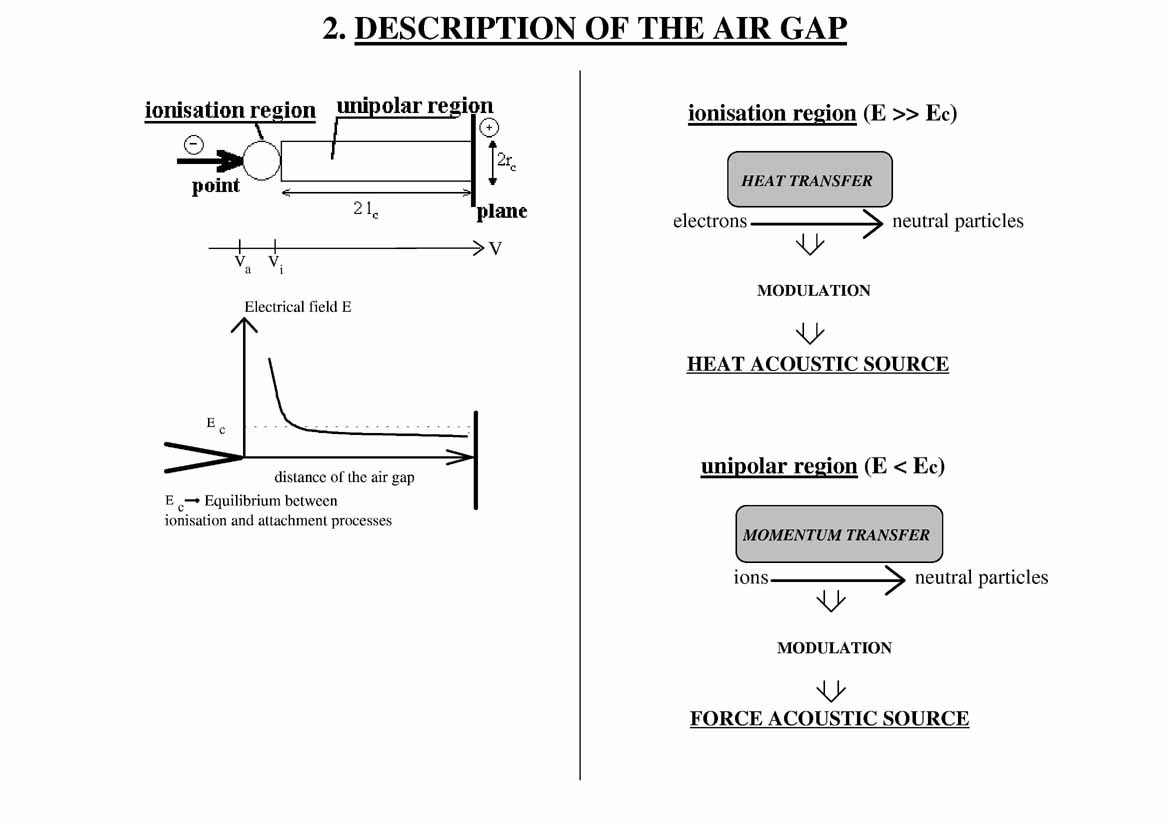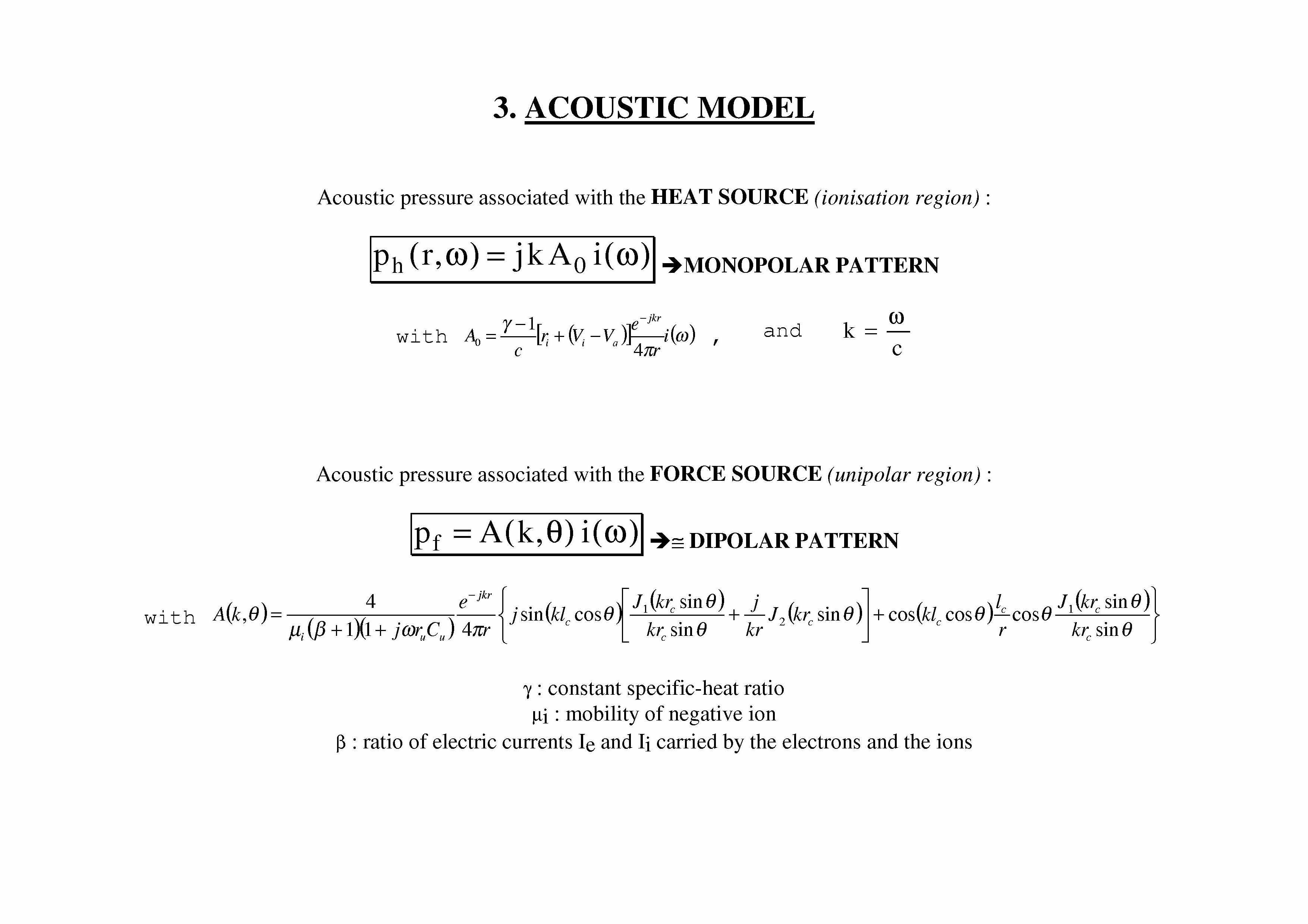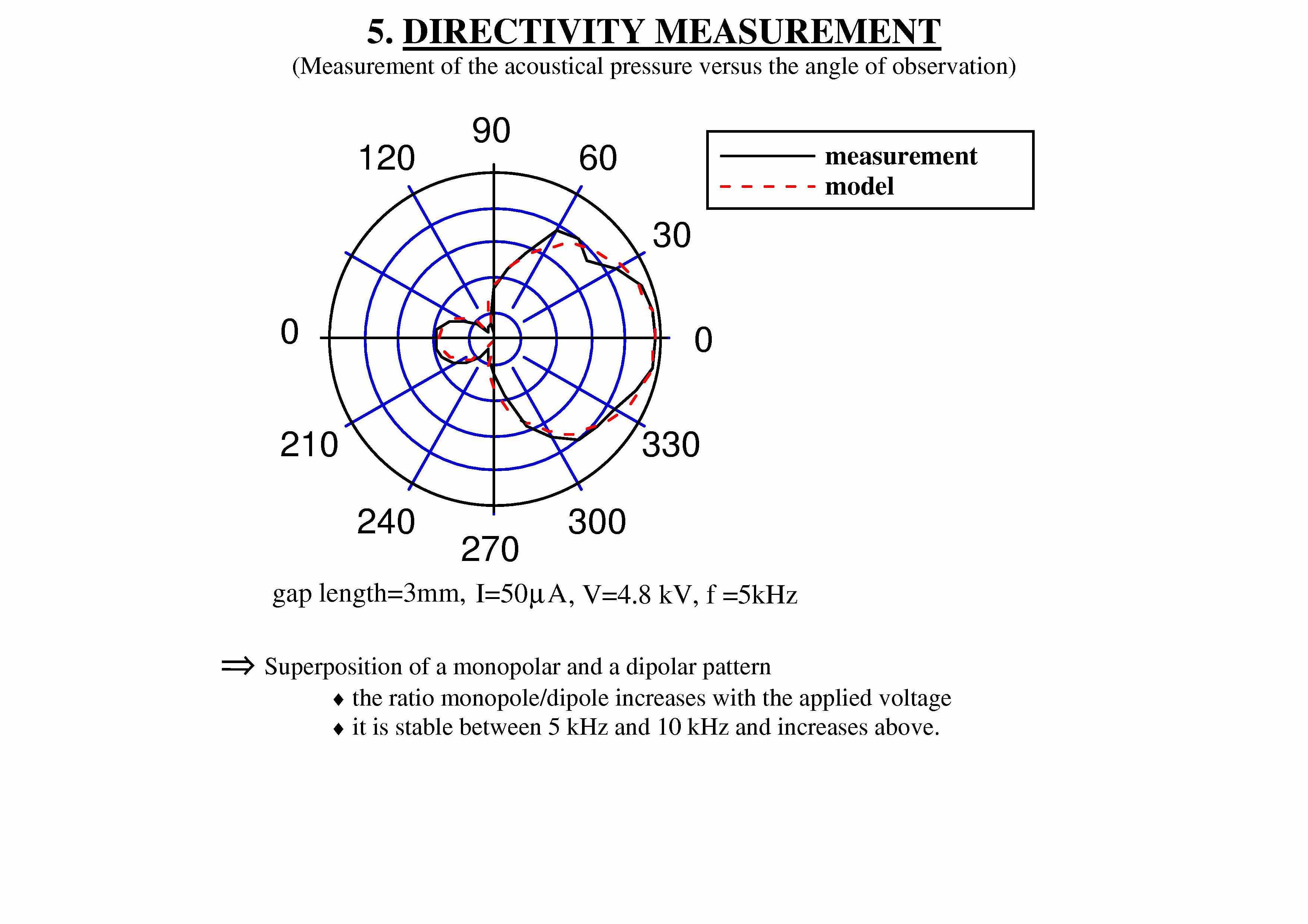For classical electroacoustic transducers (electrostatic, piezoelectric,
electrostrictive, magntostrictive, etc) the acoustic wave is created by
the vibrations of a mechanic part acting on the air molecules. Such systems
are widespread on both the domestic and the industrial fronts. Reasons
for using this technology are the facility to adapt the characteristics
of their internal elements to a particular application. However, these
types of transducers always encounter limitations due to the moveable
elements (diaphragm, etc), the coupling between the radiating element,
and the surrounding gas, and the material limitations such as overheating
or mechanical failure. That is the reason why, since their creation, these
principles and their refinement illustrate a trend toward a reduction
of the number and mass of moving parts, necessary to achieve a high efficiency
and a wide frequency range. "Plasma" loudspeakers having non
membrane at all, looks somewhat like an "ultimate" solution.
In specific applications, for which available electroacoustic transducers do not necessarily have the required characteristics, gas discharge transducers technology may be able to satisfy these peculiar requirements. The "direct transduction" character (i.e. no moving part included), and more fundamentally the "volumic" character of the associated acoustic sources, are two of the particularities that hold our attention. Lastly, the small size of these sources allows their use in confined applications, and they can also be used in harsh environments such as a high temperature medium. Although the quantity of literature concerning applications of gas discharges is quite large because of their widespread applications, there are very few publications which deal with ionised gas acoustic tranducers.

The ionisation of the air is obtained by applying a high DC (negative in our case) voltage between electrodes having different curvature radii (e.g. a needle facing a plane). The complex phenomena which take place in the electrode gap are called discharges in the gas or, when a glow appears in the gap, corona discharges. These discharges present different physical behaviours or regimes depending on the polarity or the radius of the small-radius electrode, the gap length and the gas. By choosing the appropriate geometric and electric configuration of the electrodes, but also depending on the location relative to the electrodes, the interactions between charged and neutral particles in the ionised gas can lead to either a predominant heat transfert between particles (Joule heat source, almost isotropic) or a predominant momentum transfer which creates a gas flow, the so-called "electric wind" (source force, having a specific axis).
Time variation of the heating of an air volume produces a corresponding pressure change. The "hot plasma" loudspeakers (flame sources, thermophone, ionophone) use this principle. By contrast, "cold" plasma loudspeakers are based on momentum transfer. In fact, corona discharges have intrinsically both heat and momentum transfer.
Considering a time-averaged repartition of the electric field in the gap, two regions can be distinguished. The first one, termed the "ionisation region", is located at the tip of the point and is characterised by a value of the electric field higher than the critical value (27kV/cm in air) of the electric field. In this region this strong electric field makes the ionisation processes predominant. The electric field accelerates the free charged particles to undergo ionising collisions with air molecules in this vicinity, generating more electrons and positive ions. The kinetic energy of the charged particles is thus partly transmitted to surrounding neutral particles through random collisions, leading to a heat transfer from charged particles to neutral particles. Considering the specific form of the electrodes and the physical processes, this ionisation region is very small, and can be assumed to be spherical with a radius close to 0.1mm. The heat transfer is almost isotropic throughout its volume, and its extension is very small compared to the acoustic wavelength.
The second region, termed the "drift region", takes place between the ionisation region and the plane electrode, and is characterised by a weaker and almost uniform time-average value of the electric field. Electrons produced in excess in the ionisation region thus drift along the field lines of this second region : the more energetic ones are directly collected by the plane electrode, whereas the less energetic ones are attached to neutral particles, thus building negative ions (which also drift toward the plane electrode). Collisions between the drifting ions and the neutral particles transfer momentum to the air, and create a gas flow, "the electric wind", that blows from the point to the plane.
In order to generate an acoustic field,
the electric current flowing through the electrodes is modulated at acoustic
frequencies by an external electronic circuit, leading to a modulation
of the heat and the momentum quantity exchanges between charged and neutral
particles. Then each region can be seen as an acoustic source with specific
radiation characteristics.



This PhD continues the experimental and theoretical work in order to improve the electroacoustic efficiency (optimising the configuration transducer) and the sound level. The acoustical modelling of the discharges has been developed considering the geometry of the dominating source (i.e. the force source) closer to the electric field lines than the previous modelling. Indeed, due to the geometrical divergence of the applied electric field, the drift region might be modelled as a truncated conical region, this description being in agreement with the visual observation of the discharge.
Moreover, from the previous PhD an extension of the first electroacoustic efficiency study has been made. The electric and acoustic modelling lead to the analitical formulation of the efficiency of each acoustic source that allow to consider the energy balance between both mechanisms. The experimental results enable to optimise the electric and geometric parameters to have the best efficiency.
The purpose is also to increase the sound levels generated by the loudspeaker. In the one hand, a new device has been used in order to increase the electric modulation. A study of the harmonic distorsion of the transducer concludes to the importance of the non-linear behaviour of the heat source. On the other hand, others electrodes configurations (multipoints-plane and wire-plane) has been studied in different aspects (electomagnetic interactions and acoustic modelling) to increase the emissive area.
Finally, the global gas flow called "the electric wind" represents a perturbation. Measurements using the Laser Doppler Anemometry technique have allowed to characterize its behaviour. Measurements of the acoustical velocity have been also performed. The principle of this method consists to extract the information relative to the fluid velocity from the Doppler's lag between the incident and the light emission scattered by tracers (small smoke particules) which their displacement is supposed to follow the fluid one. Unlike the classical microphone, this optical method presents the principal advantage to be insensitive to the nuisant electromagnetic radiation.